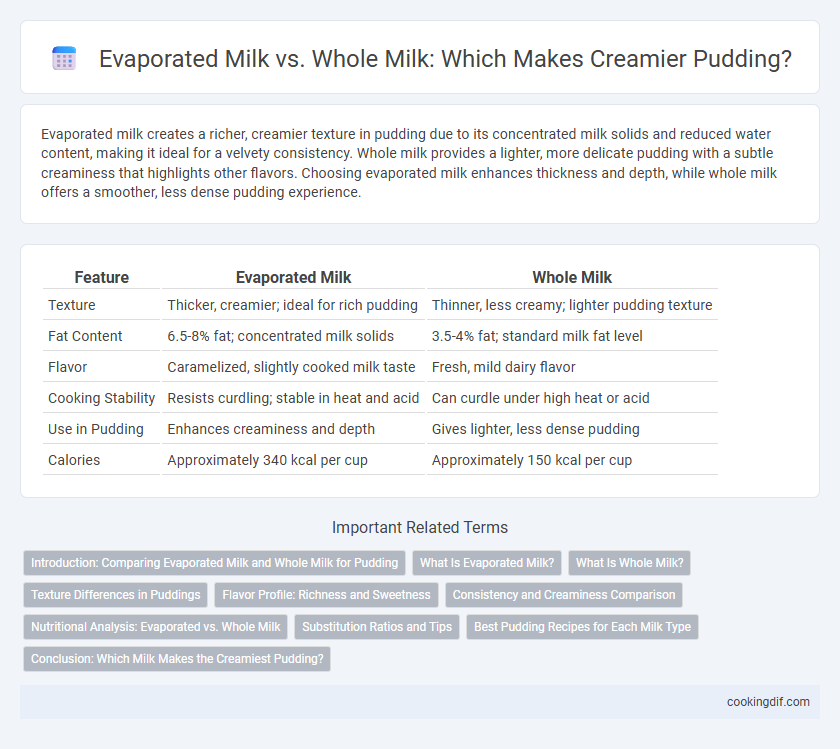Evaporated milk creates a richer, creamier texture in pudding due to its concentrated milk solids and reduced water content, making it ideal for a velvety consistency. Whole milk provides a lighter, more delicate pudding with a subtle creaminess that highlights other flavors. Choosing evaporated milk enhances thickness and depth, while whole milk offers a smoother, less dense pudding experience.
Table of Comparison
| Feature | Evaporated Milk | Whole Milk |
|---|---|---|
| Texture | Thicker, creamier; ideal for rich pudding | Thinner, less creamy; lighter pudding texture |
| Fat Content | 6.5-8% fat; concentrated milk solids | 3.5-4% fat; standard milk fat level |
| Flavor | Caramelized, slightly cooked milk taste | Fresh, mild dairy flavor |
| Cooking Stability | Resists curdling; stable in heat and acid | Can curdle under high heat or acid |
| Use in Pudding | Enhances creaminess and depth | Gives lighter, less dense pudding |
| Calories | Approximately 340 kcal per cup | Approximately 150 kcal per cup |
Introduction: Comparing Evaporated Milk and Whole Milk for Pudding
Evaporated milk offers a richer, creamier texture in pudding due to its reduced water content and concentrated milk solids, enhancing smoothness and flavor without extra fat. Whole milk provides a lighter consistency with natural creaminess and sweetness, contributing to a more delicate pudding base. Choosing evaporated milk boosts creaminess and structure, while whole milk maintains a fresher, less dense pudding experience.
What Is Evaporated Milk?
Evaporated milk is a concentrated dairy product made by removing about 60% of the water from fresh whole milk, resulting in a thicker, creamier texture ideal for puddings. Unlike whole milk, evaporated milk has a slightly caramelized flavor due to the heating process, which enhances the rich taste and smooth consistency of creamy desserts. It provides a higher fat content and less water, making it a preferred choice for achieving a velvety pudding without the need for added cream.
What Is Whole Milk?
Whole milk contains about 3.25% fat, providing a rich and creamy texture essential for smooth pudding. Its balanced fat and protein content helps create a velvety mouthfeel without overpowering sweetness. Compared to evaporated milk, whole milk offers a lighter, fresh dairy flavor ideal for classic creamy pudding recipes.
Texture Differences in Puddings
Evaporated milk creates a richer and denser texture in pudding due to its concentrated milk solids and reduced water content, resulting in a thicker and creamier consistency compared to whole milk. Whole milk produces a lighter, smoother pudding with a silkier mouthfeel, as its higher water content dilutes the mixture slightly. The choice between evaporated and whole milk directly influences the pudding's firmness and creaminess, with evaporated milk often preferred for a more indulgent texture.
Flavor Profile: Richness and Sweetness
Evaporated milk enhances pudding's creaminess with its concentrated richness and slightly caramelized sweetness, creating a deeper, more indulgent flavor profile compared to whole milk. Whole milk provides a lighter, natural dairy sweetness and a smoother texture, resulting in a milder, more delicate pudding taste. Using evaporated milk intensifies the overall flavor, making it ideal for richer, more luxurious desserts.
Consistency and Creaminess Comparison
Evaporated milk creates a denser, creamier pudding due to its reduced water content, enhancing richness and full-bodied texture. Whole milk results in a lighter, less viscous consistency, yielding a smoother but less indulgent pudding experience. Choosing evaporated milk intensifies creaminess and produces a firmer set, ideal for richer desserts.
Nutritional Analysis: Evaporated vs. Whole Milk
Evaporated milk contains a higher concentration of nutrients and calories than whole milk due to the removal of water, providing approximately 22 grams of fat and 150 calories per cup compared to whole milk's 8 grams of fat and 150 calories. The increased fat content in evaporated milk enhances the creaminess and richness of pudding while also supplying more protein and calcium, essential for texture and nutritional value. Whole milk offers a lighter, less dense alternative with fewer calories and fat, making evaporated milk a preferred choice for achieving a thicker, creamier consistency in pudding recipes.
Substitution Ratios and Tips
Evaporated milk can replace whole milk in creamy pudding recipes using a 1:1 substitution ratio, providing a richer texture due to its concentrated milk solids. For best results, dilute evaporated milk with an equal part of water when aiming to mimic the consistency of whole milk, or use it undiluted to enhance creaminess. When substituting, consider the slightly caramelized flavor of evaporated milk, which can subtly alter the pudding's taste profile.
Best Pudding Recipes for Each Milk Type
Evaporated milk creates a richer, creamier texture in pudding by concentrating the milk's natural sugars and proteins, making it ideal for custard-style and caramel-flavored puddings. Whole milk offers a lighter, smoother consistency, perfect for fruit-based or chocolate puddings that benefit from a subtle creaminess without overpowering flavors. Recipes like classic vanilla pudding shine with evaporated milk, while banana or berry puddings pair excellently with whole milk for a balanced, luscious finish.
Conclusion: Which Milk Makes the Creamiest Pudding?
Evaporated milk creates a richer, creamier pudding than whole milk due to its concentrated milk solids and reduced water content, which thickens the texture without additional cream. Whole milk produces a lighter, less dense pudding that may require extra ingredients to match the creaminess achieved by evaporated milk. For the creamiest pudding, evaporated milk is the preferred choice, delivering a smooth and velvety consistency.
Evaporated milk vs whole milk for creamy pudding Infographic

 cookingdif.com
cookingdif.com